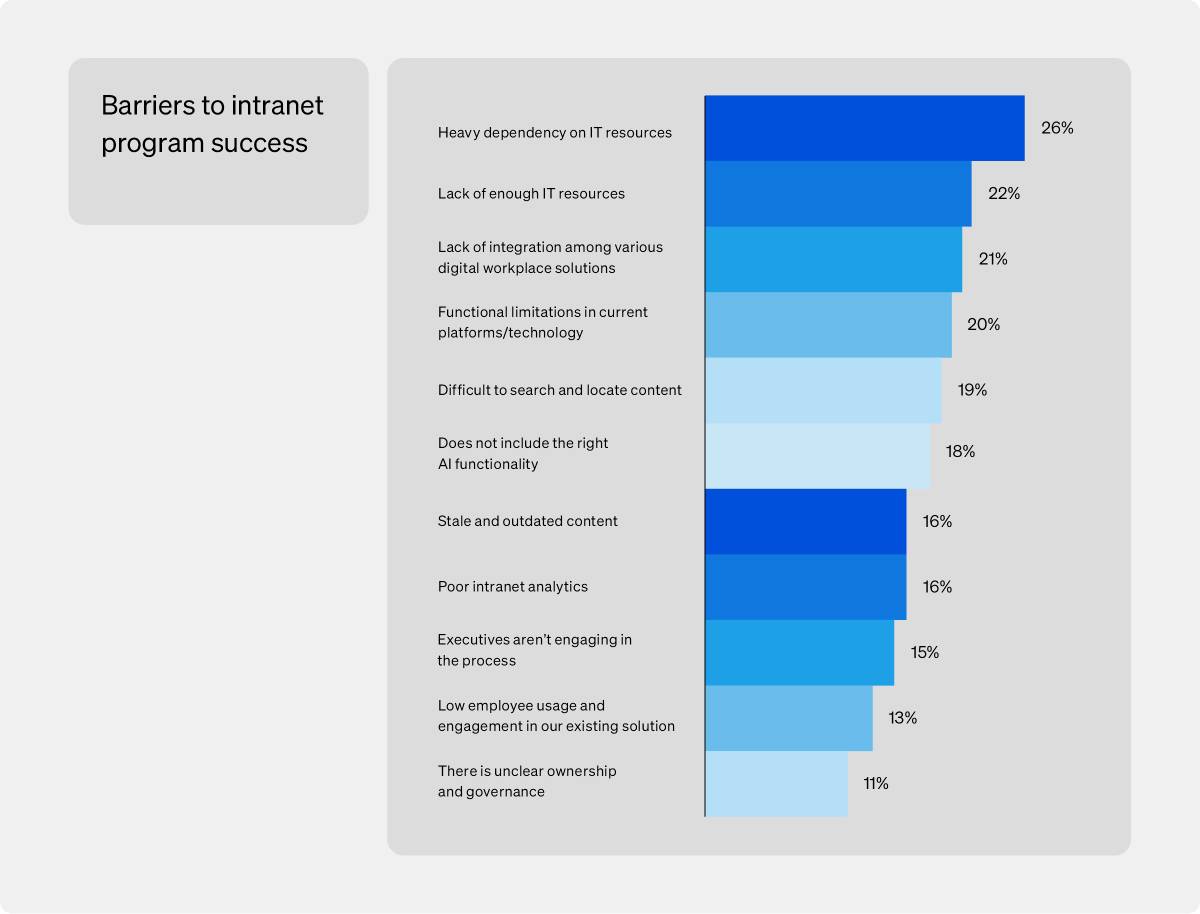Intranets have long been hailed as the central hub for communication and collaboration, yet many fall short. Instead of facilitating smooth, efficient operations, intranets often frustrate employees and bog down productivity. There are common reasons why intranets fail — as well as solutions to avoid the pitfalls of these intranet challenges.
Simpplr recently conducted extensive research to gain insights into what makes for a successful intranet — and why intranets fail. We surveyed more than 1,000 senior intranet program professionals spanning various industries, from manufacturing to retail and everything in between.
Our goal was to capture insights into what affects the quality and impact of an organization’s intranet, which has a crucial effect on business outcomes such as employee productivity, retention and revenue. What we discovered is that many companies have the same intranet problems that prevent their platforms from being effective employee engagement tools.
90% of intranets fail to achieve their initial goals.
Get your free copy of our new ebook to take a deep dive into why intranets fail and read on for highlights.

Top 10 reasons why intranets fail
Our research found that deploying and maintaining an effective intranet platform is key to boosting an organization’s performance and employee experience.
The potential benefits of an intranet are unmistakable. The majority of respondents with high-quality intranets reported increases of 50% or more on revenue, profitability, retention, productivity, customer satisfaction and sales. And more than 90% of organizations noted that an effective intranet benefited employee well-being and retention.

Unfortunately, many intranets fail to live up to this promise. Let’s take a look at the top 10 reasons why intranets fail, according to original Simpplr research, as well as tips for avoiding these common intranet development challenges.

Reason #1: IT bears too much responsibility
When IT departments shoulder the entire burden of intranet management, the platform often becomes disconnected from user needs. Whether it’s configuring the system or managing day-to-day updates, IT professionals are left to handle tasks that could be streamlined with modern intranet solutions.
48% cite heavy dependency on IT or lack of IT resources
Reducing IT involvement in intranet management with an out-of-the-box intranet solution allows for distributed ownership, reducing the pressure on IT departments while improving employee intranet experience.
Learn more: Breaking the IT dependency cycle
Reason #2: Employees lack easy access to everyday tools
A quarter of survey respondents noted that a key reason why intranets fail is due to a lack of integrations with key business systems. Intranets that neglect to integrate essential business applications create friction in daily workflows.
Employees need quick, easy access to real-time communication tools, document management and collaboration platforms. Yet, many intranet challenges stem from a fragmented experience, forcing users to juggle multiple systems. Streamlined integration of tools — like AI-powered self-service and digital collaboration platforms — boosts efficiency, enabling employees to work smarter, not harder.
When employees can find what they need without switching between these systems, the intranet becomes a go-to resource rather than an afterthought.
Reason #3: Search function is ineffective at best, abysmal at worst
Poor search functionality is one of the top intranet development challenges. Ineffective search frustrates users and hampers productivity. If employees struggle to find the information they need, they’ll waste time, grow frustrated, and avoid using the platform altogether.
81% lack consumer-grade search
To resolve this reason why intranets fail, companies can invest in AI-powered search capabilities that optimize information retrieval, helping employees find relevant content quickly and improving overall productivity.
Reason #4: Inferior UI frustrates employees
Your employees are used to consumer-grade digital experiences, but often the company intranet falls short. A clunky, unintuitive user interface (UI) turns simple tasks into headaches, causing employees to abandon the platform altogether.
70% cite ease of use as the most important intranet characteristic
Research highlights the importance of intuitive intranet design among intranet best practices. User-friendly navigation, clear visuals and a modern layout all play a key role in making the intranet a platform employees will want to use. Investing in intranet interface design pays dividends in increased usage and satisfaction.
Reason #5: Platforms have inadequate AI functionality
Artificial intelligence has the power to transform intranets from static repositories to dynamic, personalized experiences. AI-powered personalization, content management and knowledge management solutions not only save time but also significantly enhance the employee experience.
An intranet with AI built for EX can personalize experiences at scale.
Organizations that leverage AI in their intranet platforms report higher engagement levels and more efficient workflows. It’s no longer about adding basic automation but integrating AI that anticipates user needs and automates tedious tasks.
Learn more: Revolutionize the employee experience with an AI-powered EX platform
Reason #6: Content is outdated and irrelevant
Stale content erodes trust in the intranet as a reliable source of information. Outdated content is frequently cited as a reason why intranets fail. Implementing a content governance strategy is key to maintaining relevance.
Another way to combat this internet challenge is through AI-powered governance, which ensures that content is regularly reviewed, updated and removed when it’s no longer relevant. By keeping content fresh and engaging, intranets can maintain employee interest and encourage frequent engagement.
Learn more: We are digital hoarders — and our intranets are dumping grounds
Reason #7: Insufficient analytics hinder actionable insights
More than 15% of respondents cited poor analytics as one of the primary reasons why intranets fail. Without robust analytics, organizations lack visibility into how employees use the intranet and what improvements may be needed.
Analytics help track key performance indicators (KPIs) like adoption rates, engagement levels and content relevance. By integrating AI-powered analytics, companies can make data-driven decisions to refine their intranet, ultimately improving employee engagement and satisfaction.

Reason #9: Employees don’t actively use the intranet
Low adoption rates plague many intranets, but this isn’t always a sign that employees don’t care about the platform. More often, it’s a reflection of poor user experience or lack of training. Successful organizations focus on creating compelling reasons for employees to visit the intranet daily.
To increase intranet adoption, organizations can implement personalized news feeds, intranet training programs, social features and communication campaigns. When employees feel that the intranet is tailored to their needs, they’re more likely to use it regularly.
Learn more: 17 intranet best practices to raise employee engagement
Reason #10: Ownership and governance are unclear
Intranets without clear ownership and accountability structures often become digital wastelands. Successful intranets have clear governance structures, with designated roles for content creation, administration and oversight.
Establishing an effective administration structure helps keep the platform organized, up-to-date and aligned with company goals. Clear ownership ensures that the intranet remains a valuable resource rather than a neglected tool.
Put your intranet to work
A high-performing intranet can significantly impact an organization’s bottom line by improving employee communication, boosting productivity, and fostering a more engaged workforce. But for an intranet to succeed, it must address the intranet problems that often lead to failure.
By understanding why intranets fail and taking proactive steps to resolve these issues, organizations can build platforms that truly support their teams.
Simpplr’s unified employee experience (EX) platform is designed to help organizations turn their employee communication systems into powerful digital work hubs for engagement and collaboration.
Request a demo today to learn more.















